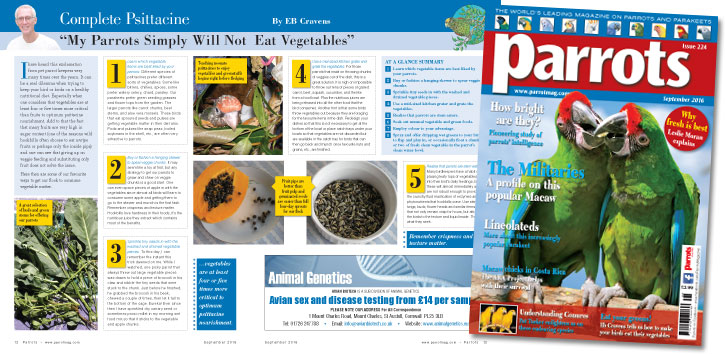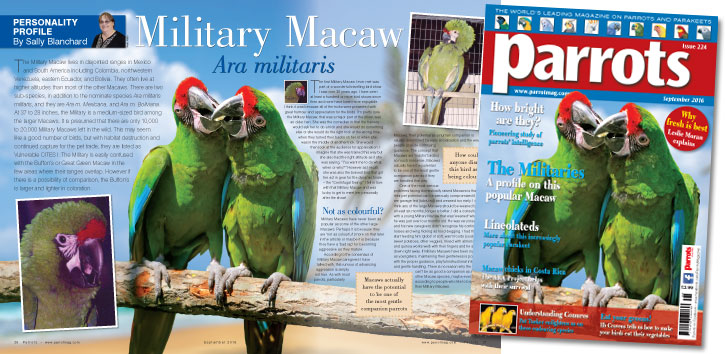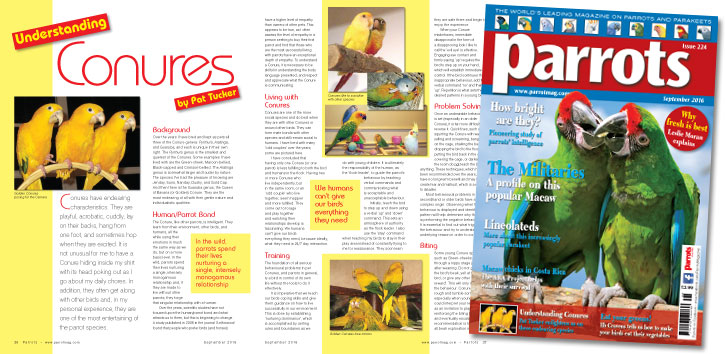
Complete Psittacine by Eb Cravens
I have heard this exclamation from pet parrot keepers very many times over the years. It can be a real dilemma when trying to keep your bird or birds on a healthy nutritional diet. Especially when one considers that vegetables are at least four or five times more critical than fruits to optimum psittacine nourishment. Add to that the fact that many fruits are very high in sugar content (one of the reasons wild hookbills often choose to eat unripe fruits or perhaps only the inside pips) and one can see that giving up on veggie feeding and substituting only fruit does not solve the issue.
Here then are some of our favourite ways to get our flock to consume vegetable matter.
Buy Now!

The Holistic Parrot by Leslie Moran
As we continue the theme of using the food we feed our birds to keep them healthy, or help restore them to good health (using food as medicine), we’re exploring the facts of how freezing affects select nutrients. For a refresher of what these nutrients specifically do to strengthen a parrot’s immune system, please see the chart in this article.
Last month we learned how freezing affects enzymes, antioxidants and vitamin C. This month we’ll explore how food containing protein, coenzyme Q10, beta-carotene, the B vitamins pyridoxine (B6) and biotin, zinc and essential fatty acids (EFAs) are affected by the freezing process.
Buy Now!

Personality Profile by Sally Blanchard
The Military Macaw lives in disjointed ranges in Mexico and South America including Colombia, northwestern Venezuela, eastern Ecuador, and Bolivia. They often live at higher altitudes than most of the other Macaws. There are two sub-species, in addition to the nominate species Ara militaris militaris, and they are Ara m. Mexicana, and Ara m. Boliviana. At 37 to 28 inches, the Military is a medium-sized bird among the larger Macaws. It is presumed that there are only 10,000 to 20,000 Military Macaws left in the wild. This may seem like a good number of birds, but with habitat destruction and continued capture for the pet trade, they are listed as Vulnerable CITES I. The Military is easily confused with the Buffon’s or Great Green Macaw in the few areas where their ranges overlap. However if there is a possibility of comparison, the Buffon’s is larger and lighter in coloration.
Buy Now!

Conures have endearing characteristics. They are playful, acrobatic, cuddly, lay on their backs, hang from one foot, and sometimes hop when they are excited. It is not unusual for me to have a Conure hiding inside my shirt with its head poking out as I go about my daily chores. In addition, they often get along with other birds and, in my personal experience, they are one of the most entertaining of the parrot species.
Over the years I have bred and kept as pets all three of the Conure genera: Pyrrhura, Aratinga, and Guaruba, and each is unique in their own right. The Pyrrhura genus is the smallest and quietest of the Conures. Some examples I have lived with are the Green-cheek, Maroon-bellied, Black-capped and Crimson-bellied. The Aratinga genus is somewhat larger and louder by nature. The species I’ve had the pleasure of knowing are Jenday, Suns, Nanday, Dusky, and Gold Cap. And then there is the Guaruba genus, the Queen of Bavaria (or Golden) Conure. They are the most endearing of all with their gentle nature and individualistic qualities.
Buy Now!




